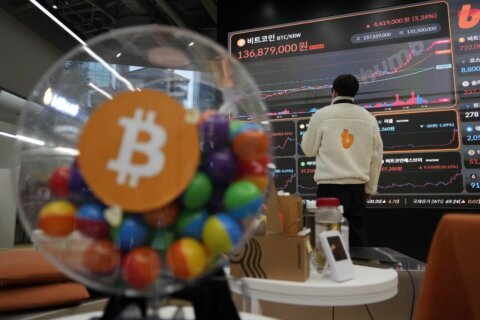OSAKA, Japan (AP) — Visitors to Tokyo and Kyoto might not realize it, but Osaka — one of Japan’s biggest and oldest cities, known more as a business hub than a tourist destination — is gearing up to host next year’s World Exposition.
The city has been plastered with the Expo’s red-and-blue “Myaku-Myaku” mascot for months and is abuzz with preparations. For many here, the excitement is mixed with nostalgia for the last World Expo hosted by Japan, back in 1970.
There are doubters, especially outside Osaka. Construction costs are turning out to be exponentially higher than expected. Preparations have been marred by political and business infighting. And many Japanese, jaded after Tokyo’s difficult experience hosting the Olympics during the COVID pandemic, question whether the idea of a World Expo is still relevant.
But in Osaka, many older residents say such events are more necessary than ever.
Many retain vivid memories of the 1970 Expo. They remember schoolchildren attending multiple times, particularly those from the Osaka area. There were long lines to see the moon rocks on view at the U.S. pavilion; prototypes of electric cars; displays featuring the first ethernet cables (LAN); and the introduction of Western foods like yogurt and baguettes.
It was a time when traveling abroad was still a dream for most, and Expo ’70 was a rare chance for ordinary Japanese to hear live performances by bands from around the world, and visit a huge array of pavilions representing various nations and interests.
Mostly, though, the enduring impact was the chance for personal interactions with international pavilions and visitors.
“My experience as an interpreter at World Expo ’70 was transformative,” says Takahiro Shinyo, who went on to join the Japanese foreign service, serve as a Japanese ambassador to Germany, and is now a visiting professor at Kwansei Gakuin University, just outside Osaka.
“It opened my eyes to the power of international cooperation and the potential of human ingenuity,” he says.
And while a lot has changed since 1970, he says World Expos remain just as relevant today.
“The value of direct interpersonal contact that World Expos facilitate cannot be replicated online,” he says. “The face-to-face interactions, the exchange of ideas, and the shared experiences that take place at these events contribute to a deeper understanding and appreciation of our global community.”
As in 1970, this World Expo is being staged in Osaka just a few years after the Olympics were held in Tokyo. But while the 1964 Olympics were an enormously successful and popular event at the time, the 2021 Tokyo Olympics, held during the pandemic, were considered a disappointment to many Japanese.
World Expos happen every five years, and last up to six months. The most recent, in 2020, was in Dubai.
The upcoming Expo in Osaka is scheduled for April 13-Oct. 13, 2025, with the theme “Designing the Future of Our Lives.” Organizers anticipate 28.2 million visitors, over 3 million of them from other countries. Nearly 5 million tickets have already been sold.
The Expo will be held on an island built off the coast of western Osaka using the same technology as at nearby Kansai International Airport, which floats in Osaka Bay. The fair promises multiple prototypes of flying cars, and spokeswoman Sachiko Yoshimura said organizers hope visitors could even take a flying car from the airport to the Expo.
That said, organizers say their emphasis is not on cutting-edge technology as much as international cooperation.
“This Expo is not just a showcase of industry. It’s about having all the nations come together and unite as one,” said Yoshimura, in a glassed-in office near the top of a skyscraper overlooking the site of the upcoming event.
Although the grounds of World Expo 2025 have begun to open up for limited tours of the construction site, the general public can get a sense of the impact of a World Exposition in Osaka by visiting ExpoCity, the site of the 1970 World Expo. It features an immersive Expo ’70 Pavilion, including the still-intact Steel Pavilion, and galleries of Expo ’70 memorabilia like uniforms worn by World Expo “hostesses.”
Visitors to ExpoCity can climb inside the nearby “Taiyo no To” (Tower of the Sun) sculpture, a symbol of Expo ’70 and designed by Japanese artist Taro Okamoto. There is also a playground, a lake with paddle boats and, nearby, “Expo Restaurant,” which sells what are billed as the same style meals served at that fair.
—-
Getting there: ExpoCity is a short monorail ride from Itami Airport, in Osaka. Tickets to the 2025 World Exposition range in price from 4,000 yen (about $25) to 6700 yen (about $42), depending on entry days, and can be purchased online at expo2025.or.jp.
Copyright © 2024 The Associated Press. All rights reserved. This material may not be published, broadcast, written or redistributed.







